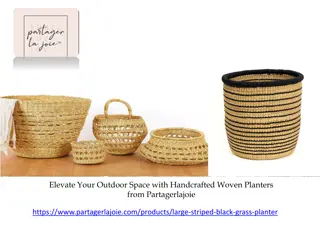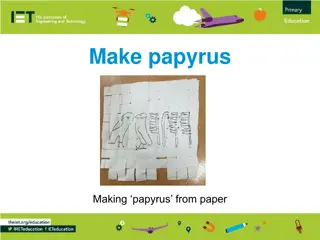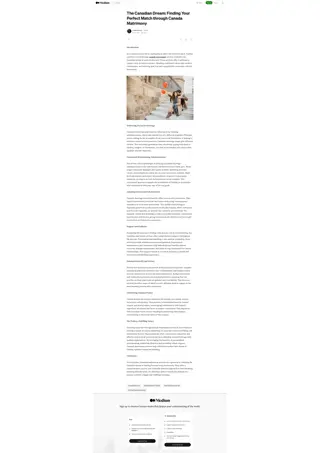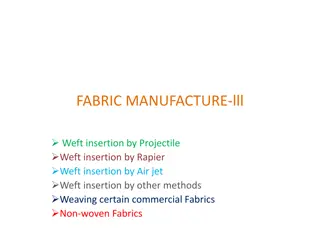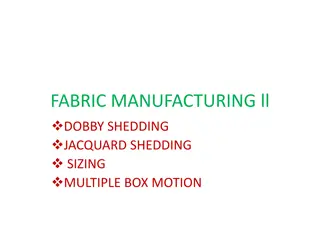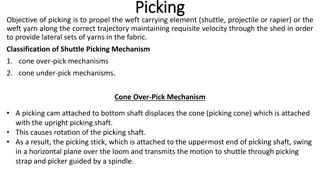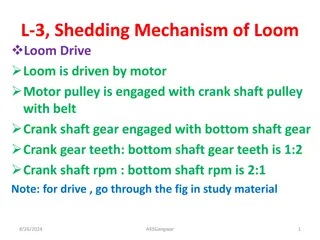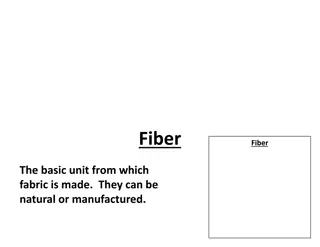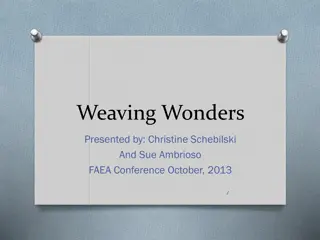Understanding Jacquard Shedding in Weaving Technology
Jacquard shedding in weaving involves a system that controls a large number of warp threads independently, allowing for intricate and detailed patterns that go beyond what a dobby system can achieve. Different types of Jacquard shedding systems exist, each with specific characteristics and working principles. Advantages of double lift Jacquard over single lift Jacquard include higher speed, semi-open shed production, and lower power consumption.
Download Presentation

Please find below an Image/Link to download the presentation.
The content on the website is provided AS IS for your information and personal use only. It may not be sold, licensed, or shared on other websites without obtaining consent from the author. Download presentation by click this link. If you encounter any issues during the download, it is possible that the publisher has removed the file from their server.
E N D
Presentation Transcript
JACQUARD SHEDDING The Jacquard is a shedding device used to produce large figures or patterns that are beyond the capacity of a dobby system. A Jacquard system is usually located above the loom and it controls a large no. Of warp threads independently by means of harness cords, hooks and needles. French weaver Joseph M. Jacquard invented Jaquard system
TYPES OF JACQUARD SHEDDING Single lift jacquard Double lift single cylinder jacquard Double lift Double Cylinder Jacquard Double lift Single Cylinder Single Hook Jacquard for high speed loom Electronic Jacquard Jacquard for special use like cross border jacquard , leno jacquard, etc.
Characteristics of Single Lift Jacquard Simple in construction. Suitable for handloom weaving. It is not suitable for high speed loom. It forms bottom closed shed and beat up is done in a closed shed. It is suitable for silk weaving and leno weaving
Working principle of Single Lift Jacquard
Working principle of single lift jacquard is shown in the figure where for lifting the warp thread only one hook, a needle, a cylinder and a knife is required. The knife is at the bottom position. A card of the perforated four sided cylinder is pressed against the needle. If there is a hole in the card, the needle opposite to the hole will pass through it and through the perforations in the cylinder. In this case the position of the hook is retained as it was and when the knife moves up it carries the hook and the warp threads connected to it are also lifted. If there is a blank opposite the needle it is pressed back and the hook is deflected from the knife, and when the knife goes up it leaves the hook at the bottom position. Therefore this jacquard produces bottom closed shed.
ADVANTAGES OF DOUBLE LIFT JACQUARD OVER SINGLE LIFT JACQUARD It works at a greater speed (140 to 180picks/min) than the single lift jacquard which runs about (120picks/min) without increased wear and tear. In most of the double lift jacquard the moving parts work at half the speed of the crank shaft, whereas in a single lift jacquard all the moving parts works at the same speed as the crank shaft. The double lift jacquard produces a semi-open shed therefore all the advantages of semi-open shed is obtained here but a single lift jacquard produces a bottom closed shed which imposes a great strain upon the rising threads. In a double lift jacquard a greater numbers of picks per inch can be inserted as the weft is beaten up in a crossed shed but in a single lift jacquard there is always a tendency to recede back and slip the weft from the fell of the cloth. The double lift jacquard consumes a lower amount of power and cause less wear and tear of the machine parts than a single lift jacquard.
ADVANTAGES OF DOUBLE LIFT JACQUARD OVER SINGLE LIFT JACQUARD The double lift jacquard has the following advantages over the single lift jacquard. It works at a greater speed (140 to 180picks/min) than the single lift jacquard which runs about (120picks/min) without increased wear and tear. In most of the double lift jacquard the moving parts work at half the speed of the crank shaft, whereas in a single lift jacquard all the moving parts works at the same speed as the crank shaft. The double lift jacquard produces a semi-open shed therefore all the advantages of semi-open shed is obtained here but a single lift jacquard produces a bottom closed shed which imposes a great strain upon the rising threads. In a double lift jacquard a greater numbers of picks per inch can be inserted as the weft is beaten up in a crossed shed but in a single lift jacquard there is always a tendency to recede back and slip the weft from the fell of the cloth. The double lift jacquard consumes a lower amount of power and cause less wear and tear of the machine parts than a single lift jacquard.
ADVANTAGES OF DOUBLE LIFT JACQUARD OVER SINGLE LIFT JACQUARD The double lift jacquard has the following advantages over the single lift jacquard. It works at a greater speed (140 to 180picks/min) than the single lift jacquard which runs about (120picks/min) without increased wear and tear. In most of the double lift jacquard the moving parts work at half the speed of the crank shaft, whereas in a single lift jacquard all the moving parts works at the same speed as the crank shaft. The double lift jacquard produces a semi-open shed therefore all the advantages of semi-open shed is obtained here but a single lift jacquard produces a bottom closed shed which imposes a great strain upon the rising threads. In a double lift jacquard a greater numbers of picks per inch can be inserted as the weft is beaten up in a crossed shed but in a single lift jacquard there is always a tendency to recede back and slip the weft from the fell of the cloth. The double lift jacquard consumes a lower amount of power and cause less wear and tear of the machine parts than a single lift jacquard.


